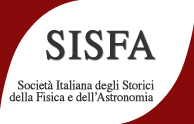Conveners
Storia della fisica e dell'astronomia / History of Physics and Astronomy
- Chairperson: Valeria Zanini
Storia della fisica e dell'astronomia / History of Physics and Astronomy
- Chairperson: Mauro Gargano
Storia della fisica e dell'astronomia / History of Physics and Astronomy
- Chairperson: Salvatore Esposito
Storia della fisica e dell'astronomia / History of Physics and Astronomy
- Chairperson: Luca Guzzardi
Storia della fisica e dell'astronomia / History of Physics and Astronomy
- Chairperson: Lucio Fregonese
Storia della fisica e dell'astronomia / History of Physics and Astronomy
- Chairperson: Elena Angeli
In 1912, using the 'absolute vector calculus without coordinates' introduced a few years earlier together with Cesare Burali-Forti, Roberto Marcolongo provided an 'intrinsic' formulation—vectorial and coordinate-free—of the Lorentz-Poincaré transformations. The Lorentz-Poincaré-Marcolongo transformations are no longer solely interpretable as passive transformations between different inertial...
The notion of weak isospin is usually associated with the birth of the standard model during the Sixties of the last century. However the idea of attributing to leptons a symmetry and quantum numbers analogous to isospin is much older, and the first instance of this idea can be found in a paper published in Nuovo Cimento in 1953 by Marcello Cini and Agusto Gamba. We discuss the most...
Until a few decades ago, it was widely believed that the period of the so-called “Scientific Revolution” had introduced a radical caesura within the way of doing science compared to the previous tradition, definitively consecrating the rational scientific method and discarding all those magical, theological and alchemical approaches that had impregnated the scientific modus operandi up to that...
This talk examines the multifaceted scientific and technical reception of Bell's telephone in Italy during the crucial years of 1877–1878. After Bell patented his telephone in 1876, news of the 'speaking telegraph' reached Italy in February 1877 via the newly established journal L'Elettricista, edited by Lamberto Cappanera. Technical information subsequently circulated through specialised...
In the eighteenth century, Naples played a pivotal role in the dissemination of Newtonian physics and the study of atmospheric electricity. A vibrant scientific community, including Della Torre, Bammacaro, Ardinghelli, and Poli, fostered experimentation and innovation. In a context of environmental vulnerability, conceptualized as South-risk, the city cultivated early forms of...
A historical account of the meteorological observations carried out in Naples in the XIX century is here presented. After a brief overview of the institutions operating in the Neapolitan area and of the corresponding scientific activity, a preliminary report is given of a little-known observational activity pursued within the Real Gabinetto Fisico of the King of Two Sicilies, as testified by...
We examine the life and military-scientific contributions of Agustín Codazzi (1793-1859), highlighting his pivotal role as a pioneer of applied physics and technical education in Latin America. Drawing on his solid European scientific training at the prestigious Scuola Teorético-Pratica d'Artiglieria in Pavia, Codazzi became a key figure in the institutionalization of science education,...
Among the physicists of the University of Perugia in the 19th century, the figure of Francesco Orioli emerges as one of the most famous who taught in Perugia. He was born in Vallerano (Viterbo) in 1783 and died in Rome in 1856. He was appointed professor of Physics in 1813 at the University of Perugia and then moved to the University of Bologna. He remained in Bologna until the riots of 1831,...
Maria Kahanovicz (1890-1936), of Polish origin, who graduated with degrees in Mathematics and Physics from the University of Naples, represents an interesting example of a female physicist from the early 20th century. A libera docente (lecturer) in Experimental Physics, she was invited to teach Applied Physics for Medicine and, later, also Mineralogy at the newly established University of Bari...
The cooperative endeavors that permeate modern science, especially following its remarkable expansion in the twentieth century, have become a focal point of discussion in the history and philosophy of science. In this paper, I apply the joint commitment model—a prominent framework in the social epistemology of groups and the organization of their cognitive labor—to nuclear fusion research....
Curie’s 1894 celebrated paper on symmetries has been examined by a previous paper through both its doubly negated propositions of intuitionist logic and its kind of theoretical organization; which was forced by the author to appear as an axiomatic-deductive one; instead it is a problem-based one because it presents ad absurdum arguments and applies to the conclusion of such arguments the...
In the previous two congresses we have respectively detailed (1) the genesis of John Wheeler's idea of a partecipatory universe and the role of a "super-Copernican" community scattered across spacetime and (2) how all that was linked to Wheeler's changing views on the nature of the observer in quantum physics and to his slogan "it from bit". We have thus shown how these topics, intertwined...
This paper discusses Galileo's contribution to the understanding of the principles of dynamics. Much has been said about his contribution to the formulation of the principle of inertia and about his experimental confirmation of horizontal inertia. Yet Newton, in his Philosophiae Naturalis Principia Mathematica, stated that Galileo had knowledge of the first two laws of dynamics, thanks to...

